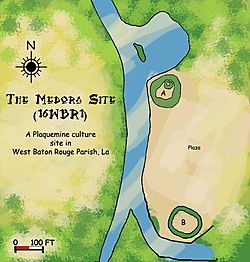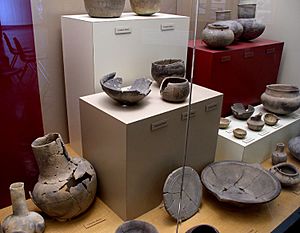Medora site facts for kids

Diagram of the Medora site
|
|
| Location | Plaquemine, Louisiana, West Baton Rouge Parish, Louisiana, United States |
|---|---|
| Region | West Baton Rouge Parish, Louisiana |
| Coordinates | 30°19′36.34″N 91°12′5.65″W / 30.3267611°N 91.2015694°W |
| History | |
| Founded | 1300 CE |
| Cultures | Plaquemine culture |
| Site notes | |
| Excavation dates | 1939-1940 |
| Archaeologists | James A. Ford, George I. Quimby |
| Architecture | |
| Architectural styles | Platform mounds, Plaza |
| Responsible body: private | |
The Medora site (also known as 16WBR1) is a very important archaeological site in Louisiana, USA. It helps us understand the ancient Plaquemine culture. This culture is named after the nearby town of Plaquemine, Louisiana.
People lived at the Medora site from about 1300 CE to 1600 CE. The site had two large mounds and a flat open area called a plaza. In the winter of 1939-1940, archaeologists dug up the site. This work was led by James A. Ford and George I. Quimby. Their discoveries helped experts learn a lot about the Plaquemine culture.
Contents
Discovering the Medora Site
Where is Medora?
The Medora site is in West Baton Rouge Parish, Louisiana. It is right next to a small stream called Bayou Bourbeaux. This area is a flat flood plain near a big bend in the Mississippi River. The land is often wet and can flood because it is only about 20 feet (6.1 m) above sea level.
The site is part of a large farm called Medora Plantation. This is where the site gets its name. Farmers had grown crops on this land for many years before the archaeologists started digging.
When was Medora Inhabited?
Scientists were able to figure out when people lived at the Medora site. They used clues from both geology and archaeology. A map of old river paths showed that the land where Medora is located was not formed until about 1300 CE. This means people could not have lived there before that time.
Also, all the objects found at the site belonged to the Plaquemine culture. There were no objects from the later Natchez culture, which started around 1700 CE. So, experts believe people lived at Medora from about 1300 CE to 1600 CE.
The Mounds and Plaza
The main part of the Medora site was set up with a pyramid-like mound and a plaza. Mound A was a large platform mound. It was about 125 feet (38 m) to 130 feet (40 m) wide at its base. It stood about 10 feet (3.0 m) high. The top of the mound was flat. There was a small, round bump on one corner of the top. This bump made that part of the mound about 13 feet (4.0 m) high. A temple or important building likely stood on top of this mound.
About 400 feet (120 m) away from Mound A was a smaller mound, called Mound B. It was about 100 feet (30 m) wide and 5 feet (1.5 m) high. Over time, farming and floods made it flatter, so it is now only about 2 feet (0.61 m) high. Underneath Mound B, archaeologists found traces of a house or temple. It had a round fire pit in the middle. Both mounds were built by people carrying loads of clay and silt in baskets.
Between Mound A and Mound B was a large, open plaza. It was about 400 feet (120 m) long and 200 feet (61 m) wide. This plaza was probably used for gatherings and ceremonies.
What They Found: Artifacts
Pottery Clues

Archaeologists found more than 18,500 pieces of pottery at the Medora site! These pieces are called sherds. Most of the pottery was plain, but about 10 percent had decorations. The designs were simple lines, made by scratching, engraving, brushing, or poking the clay. These designs were usually on the rim of the pots.
The pottery was generally soft and made from clay. It was not fired at very high temperatures. The colors were usually gray or tan. The most common shapes were jars and bowls. These pottery pieces tell us a lot about the daily lives and artistic skills of the Plaquemine people.
Stone Tools and Games
Even though a lot of pottery was found, only seven stone objects were discovered at Medora. Some reddish pebbles of flinty stone were found in Mound A. These stones do not naturally occur in the Medora area. This means people must have brought them from other places, perhaps from near Natchez, Mississippi.
Only three chipped flint projectile points (like arrowheads) were found. However, several polished objects made of greenstone and sandstone were discovered. These included two greenstone celts (like small axes) and a sandstone discoidal. A discoidal is a round, disc-shaped stone. It was likely used in a game called chunkey. This game was played by many Native American groups in the Southeast. It is very possible that chunkey was played in the plaza at the Medora site.
An earspool made of fired clay was also found in Mound A. It was about 3 centimetres (1.2 in) wide and had engraved geometric designs.
How They Dug It Up
The Medora site was part of a farm and had been plowed for many years before it was excavated. In the winter of 1939-1940, the Louisiana State Archaeological Survey started digging at the site. This was a joint project between Louisiana State University and the Works Progress Administration.
The excavation was led by James A. Ford and George I. Quimby. Their work at Medora was very important. It helped archaeologists understand the main features of the Plaquemine period and culture. The owner of the land, W. L. Grace, Jr., gave permission for the archaeologists to study the site.



